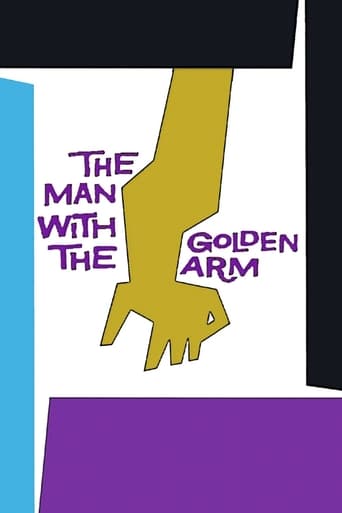

If you only see one Frank Sinatra movie in your lifetime, watch The Man with the Golden Arm. Not only was it the best performance of his acting career, but Frankie himself always felt he should have won his Oscar for this film, instead of From Here to Eternity. I wholeheartedly agree.Frankie plays "Frankie Machine", a former heroin addict and card dealer who returns to his hometown after a stint in jail. While he's been away, his wheelchair-bound wife, Eleanor Parker, has been taken care of by his drug dealer, Darren McGavin, who expects Frankie to show his gratitude now that he's returned. But Frankie wants a new life, a clean life. As he struggles to fight intense temptation, he learns how hard it is to stay sober.Kim Novak is inarguably beautiful, and I love her in Picnic, so I don't want to dis her that much. Sufficed to say, her performance was the only lackluster one in the film. Darren McGavin, best known for his bumbling, laughable performance in A Christmas Story, plays a wonderful villain: slimy, motivated, and convincing as he pretends to care. Eleanor Parker is unrecognizable in her haggard, desperate role. I watched The Sound of Music for the hundredth time and asked my mom, "Eleanor Parker was so pretty. Did she make any other movies?" My mom said, "She was in a movie you love: The Man with the Golden Arm!" My response was, "She was? What part did she play?" That says everything.Sometimes composers write themes within a film for specific characters, like in Ben-Hur or The Best Years of Our Lives. In Elmer Bernstein's fantastic score, Temptation itself is given a theme. Once you've heard the music to The Man with the Golden Arm, you'll never forget it. Combined with Otto Preminger's wonderfully rugged and classy directing style, whenever the music starts, you'll get goosebumps as the scene of temptation plays out. The story is heart-breaking and incredibly real.Nowadays, making movies about drugs isn't a novelty. Showing the use of heroin doesn't even shock audiences anymore. In 1955, during the reign of the Hays Code, a movie like this just wasn't made. In fact, it wasn't granted a seal of approval and wasn't allowed to be shown in some movie theaters during the release. Although there's no escaping the classic feel of Otto Preminger's masterpiece, it's just as gruesome and realistic as if it were made today. Drug use is shown, as well as the ungodly horrors of withdrawals. Every time I watch it, I still can't believe it was made in 1955—so groundbreaking! I've said before that this was Frank Sinatra's best performance, but in fact, it's one of the best screen performances of all time. Watch it. I'm sure you'll agree.Kiddy warning: Obviously, you have control over your own children. However, due to some drug use and adult content, I wouldn't let my kids watch it.
... View MoreFrankie Machine is a drug addict. He has just been released from jail and wants to straighten out his life. However, his life is a perpetual struggle against his addictions and his past.One of the first, if not THE first, movies to cover the subject of drug addiction. Great, engaging, thrilling story, well-directed by Otto Preminger. The more you get into the movie, the more the lead character seeks trapped and running out of options - the claustrophobia is palpable. Solid performance in the lead role by Frank Sinatra. He brings all the street-cred he can muster to the role. Good supporting performances too.
... View MoreDate: August.26, 2012 -First Time Watch- Frankie Machine (Sinatra) returns home after six months in rehab, determined to not fall back into all ways. But his wife, Zosh (a complete psychopath if you ask me) and his card buddies continue to try to bring him back down and get hooked again. This is one of the first movies to address drug addiction and the writers did a real job presenting it. The movie itself is like a six or seven but what boosted it up to a nine for me was Sinatra's performance. He was outstanding! He played a drug addict so good and the scene when he's in Molly's apartment quitting cold turkey is just so raw. It was like what you expected a person to be going through with drawls. I'm really surprised Sinatra didn't win the Oscar for this, he was nominated but it went to Ernest Borgnine for 'Marty'. I haven't seen 'Marty' yet but I find it hard that Borgnine was able to beat Sinatra's performance in this. I read that Sinatra firmly believed that this movie was more deserving of the Oscar then his role of Maggio in 'From Here to Eternity' and honestly I can see why he said it. The movie was very solid and very worth wild watching.9/10
... View MoreThis movie has dated.....and dated badly. The fact that the whole movie is made in the studio doesn't help. (Frank Sinatra did not like working on location). It has the feel of an old "Play of the Week" about it. The thing that sinks this from the very beginning is the terrible acting of Frank Sinatra. I got the feeling he was really trying----but you can act----or you cant act. Frank Sinatra was a great singer. But..he could not act. Kim Novak is very good in this, cautionary tale about drug addiction. In its day....The Man With The Golden Arm caused quite a stir....indeed it was one of the very first films to tackle this subject. The Lost Weekend starring Ray Milland, made a few years earlier is about alcoholism. It is vastly superior to this movie.
... View More